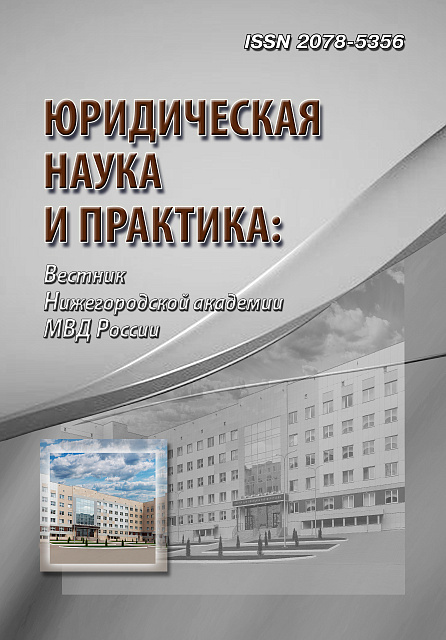The author refers to the Soviet period of our country’s history and characterizes the interaction of the state and society of that time. The instruments of interaction are named as citizens’ appeals, elections, orders to deputies, reports of deputies, appeals with letters to the media, citizens’ meetings. Particular attention is paid to appeals. It is noted that the right to appeal was not enshrined in the Soviet Constitutions until 1977, but working with them was given great importance, since they were considered a form of feedback with the population, gave an assessment of the work of government bodies, were a source of information about problems, helped in finding new solutions and ideas. Such a channel was adequate to the technical and technological conditions of that time. Over 70 years, society demonstrated both active and passive forms of adaptation to the state. It is concluded that in the USSR, legal conditions were created for the active involvement of citizens in the work on the implementation of state functions. The dual nature of the relationship between society and the state is characteristic of the USSR period: the monopolization of power by the nomenclature and the mass involvement of society in governing the state.
interaction between society and the state, USSR society, citizen involvement, workers’ participation, appeal to the USSR, citizen complaints, adaptation of society
1. Gobozov I. A. Society and the state: their interaction. Philosophy and society, 2011, no. 2, pp. 5–22. (In Russ.)
2. Matuzov N. I., Malko A. V. Theory of state and law: textbook. Moscow: Jurist, 200. 245 p. (In Russ.)
3. Theory of state and law: textbook / ed. by V. N. Zhukov, E. A. Frolova. Moscow: Prospect, 2024 .640 p. (In Russ.)
4. Osin R. S. Soviet society: essence, tendencies and contradictions of development. author’s abstract. Dissertation... candidate of philosophy sciences. Moscow, 2015. 24 p. (In Russ.)
5. Popova O. D. “Letters to the Authorities” as a Source for Studying the Standard of Living of Soviet Citizens in the 1950s-60s // Development of the Territory in the Context of Modern Challenges: (X Ryazan Sociological Readings): Proceedings of the National Scientific and Practical Conference, Ryazan, November 12–13, 2020 / Responsible. editor R. E. Markin. Ryazan: OOO “Ippolitov Publishing House”, 2020. Pp. 64–69. (In Russ.)
6. Denninghaus V., Savin A. I. On Collide Courses: Political Co-Adaptation of Power and Society in the Brezhnev Era. Dialogue with Time, 2015, no. 53, pp. 279–293. (In Russ.)
7. Constitution (Basic Law) of the Russian Socialist Federative Soviet Republic (adopted by the V All-Russian Congress of Soviets on July 10, 1918). Access from the reference legal system “ConsultantPlus”. (accessed 01.11.2024). (In Russ.)
8. On strict observance of laws: Resolution of the VI All-Russian Congress of Soviets of November 8, 1918. URL: https://docs.historyrussia.org/ru/nodes/95708-postanovlenie-vi-vserossiyskogo-chrezvychaynogo-sezda-sovetov-rabochih-i-krestyanskih-deputatov-o-tochnom-soblyudenii-zakonov-8-noyabrya-1918-g (accessed 15.11.2024). (In Russ.)
9. On the Elimination of Red Tape: decree of the Council of People’s Commissars of the RSFSR of December 30, 1919. URL: https://docs.historyrussia.org/ru/nodes/16656-30-dekabrya-postanovlenie-snk-ob-ustranenii-volokity-v-sovetskih-uchrezhdeniyah (accessed 15.11.2024). (In Russ.)
10. Sukharev A. A. Power and society of a trans-Ural city under the NEP: 1921–1929 (based on materials from Tyumen). Dissertation... candidate of legal history sciences. Tyumen, 2014. 25 p. (In Russ.)
11. Ilyazova R. V. Anti-religious propaganda in the USSR in 1918–1941 (based on materials from the Simbirsk-Ulyanovsk region). Dissertation... candidate of legal history sciences. Saransk, 2021. 23 p. (In Russ.)
12. Constitution (Basic Law) of the Union of Soviet Socialist Republics (approved by the Resolution of the Extraordinary VIII Congress of Soviets of the USSR of December 5, 1936. Izvestiya of the Central Executive Committee of the USSR and the All-Russian Central Executive Committee, 1936, no. 283. (In Russ.)
13. Materials of the February-March Plenum of the Central Committee of the All-Union Communist Party (Bolsheviks) of 1937. March 3, 1937. Evening session. Report by Comrade Stalin. Questions of History, 1995, no. 3, pp. 3–15. URL: https://istmat.org/node/30245 (accessed 10.11.24). (In Russ.)
14. Materials of the XIX Congress of the All-Union Communist Party (Bolsheviks) — CPSU - G. M. Malenkov. Report of the Central Committee of the All-Union Communist Party (Bolsheviks) to the XIX Party Congress URL: https://stalinism.ru/dokumentyi/materialy-xix-s-ezda-vkp-b-kpss.html?showall&start=5 (accessed 10.11.24). (In Russ.)
15. Boychenko L. V. Legal bases of interaction between the state and society in the 60s of the twentieth century. Education and law, 2013, no. 8, pp. 152–155. (In Russ.)
16. Resolution of the Central Committee of the CPSU. On improving the work on considering letters and organizing the reception of workers. August 29, 1967. Party Life, 1967, no. 18, pp. 8–10. (In Russ.)
17. On the procedure for considering proposals, applications and complaints of citizens: decree of the Presidium of the Supreme Soviet of the USSR of April 12,1968 no. 2534-VII/ Access from the reference legal system “ConsultantPlus”. (accessed 11.11.2024). (In Russ.)
18. Kishchenkov M. S., Nikiforov Yu. S., Tumakov D. V. Bureaucratic practices of the Yaroslavl regional elite in working with letters from citizens in the USSR in the 1960s. Modern history of Russia, 2021, vol. 11, no. 1, pp. 134–148. (In Russ.)
19. Nikiforov Yu. S., Sirotkin Ya. N. Complaints of Soviet citizens as a cultural phenomenon of the era of late socialism. Upper Volga Philological Bulletin, 2019, no. 4 (19), pp. 216–221. (In Russ.)
20. On the People’s Control Bodies in the USSR: law no. 4224-VI of the USSR of December 9, 1965. Vedomosti of the Supreme Soviet of the USSR, 1965, no. 49, art. 718. (In Russ.)
21. Code of Laws of the USSR. 1990. Vol. 3. P. 14. The original text of the document was published in the publication. Vedomosti of the Supreme Soviet of the USSR, 1977, no. 41, art. 617. (In Russ.)
22. Kim L. I., Barnasov A. M. People’s Representation in the USSR. Tomsk: Tomsk University Publishing House, 1982. 91 p. (In Russ.)
23. Boltenkova L. F. Forms of democracy in the Russian state: IX–XVI centuries. Cossacks, 2016, no. 3 (16), pp. 33–46. (In Russ.)












